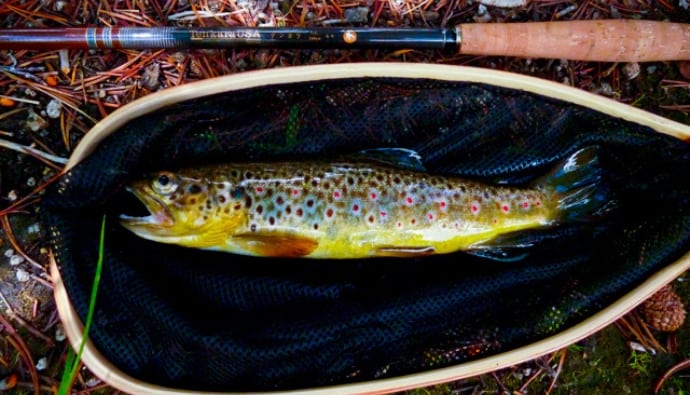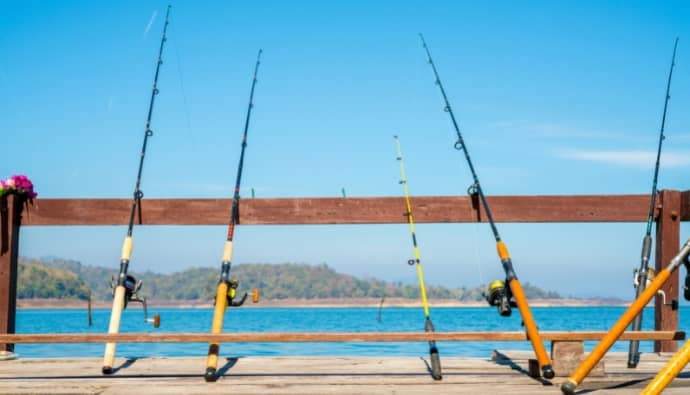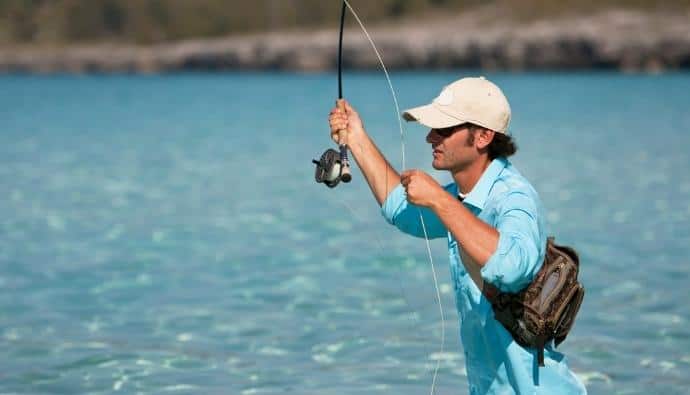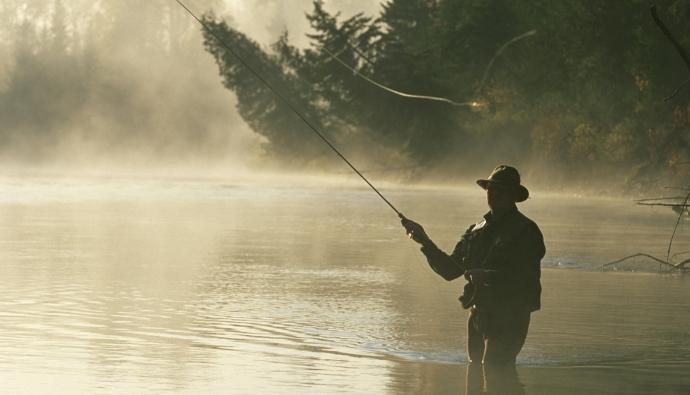There are many ways to catch fish, but the two that stand out the most are fly fishing and regular fishing. Not only do they use different gear, but they also have different cultures. In this article, we will go deep into the similarities and differences.

The Short Answer
Fly fishing and regular fishing differ in their equipment, targeted species, and techniques. Fly fishing uses light lures, such as flies, and a special fly fishing line that’s weighted to get the lure to the proper location with the correct presentation. Regular fishing can use either lure, live bait, or cut bait.
The Long Answer
Fly fishing and regular fishing (often referred to as spin or bait casting) differ in technique, equipment, and, sometimes, the species targeted. Fly fishing utilizes the weight of the line to cast a nearly weightless fly, often attempting to mimic specific insects or other prey at different stages of their life cycle. It’s frequently used for species like trout and salmon in rivers or streams.
On the other hand, regular fishing uses a weighted lure or bait and the casting momentum to reach desired distances. This method is more versatile, being applicable in various environments, including oceans, lakes, and rivers, and for a broader range of fish species. The choice between the two usually depends on personal preference, the specific conditions in which you’re fishing, and the species you’re targeting.
What is Fly Fishing?
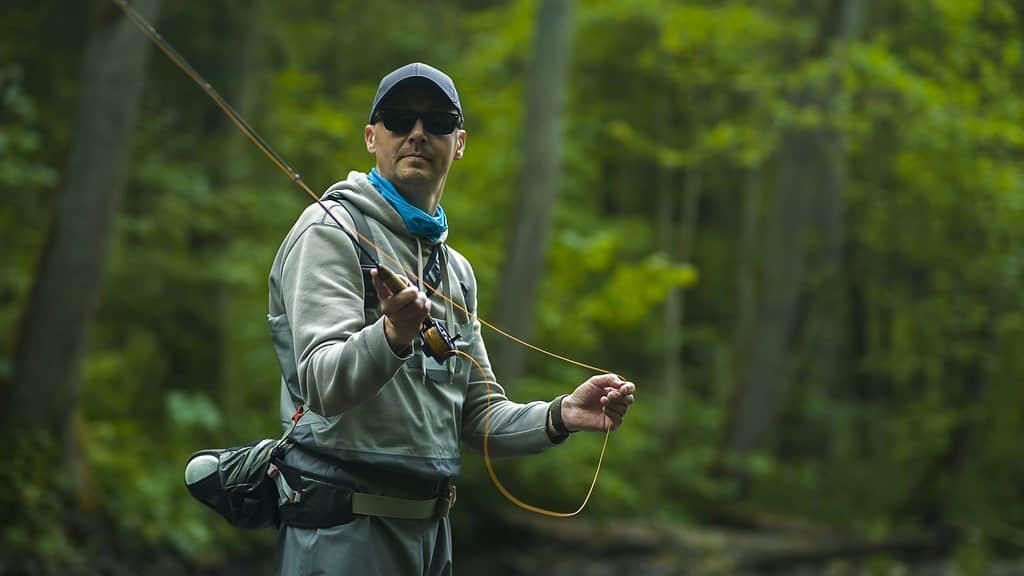
Fly fishing is a beautiful ballet on the water.
This type of fishing weaves a story with a lightweight star, known as a fly. Unlike its fishing cousins, here the weight of the line, not the lure, guides the hook through the air. It’s an intriguing puzzle, one that asks for both skill and patience.
Fly Fishing Gear
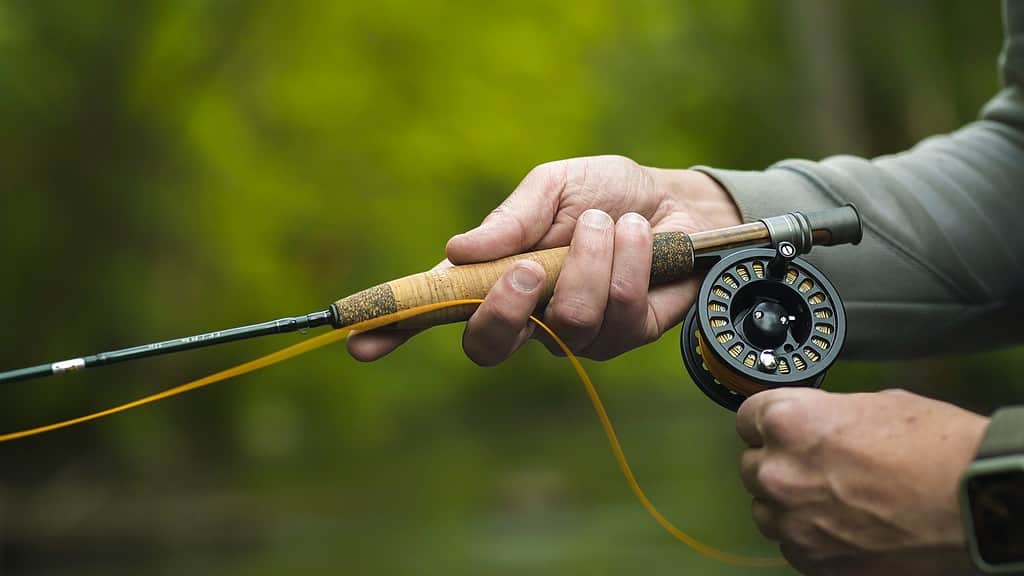
It comes with its unique set of gear.
You’ll need a few dance partners: a fly reel and rod, fly fishing line, flies, and other fly fishing accessories. The rod, long and bendy, is the dancer, leading the lightweight fly in its waltz. The fly line, heavy and flexible, is the stage, creating the path for the fly to reach its audience – the fish. And the flies? They’re the costumes, tiny fly fishing lures crafted from feathers and thread, posing as insects.
Fishes Commonly Caught With Fly Fishing
It is a standing ovation among trout and salmon fans.
These fish dine on insects above and below the water’s surface, making them the ideal audience for the fly fishing ballet. But the dance card isn’t exclusive to trout and salmon. Bass, pike, and even some saltwater species will gladly join the fly fishing dance!
Pros and Cons of Fly Fishing

However, like any good performance, fly fishing has its challenges.
Casting a fly rod takes practice. It’s more physically demanding than regular fishing, and it requires a good understanding of insect behaviors and river currents. And the curtain call? It’s absolutely worth it. With each cast, you’ll feel a deeper bond with nature, a fulfilling challenge, and the electrifying thrill of reeling in a fish in a way that a fly fisherman experience.
Just like any grand performance, fly fishing has its highs and lows.
One of the brightest spotlights for a fly fisherman shines on the satisfaction of mastering a complex skill. It’s also a globetrotter – you can perform the fly fishing dance in both freshwater and saltwater stages. But beware, the steps can be tricky to learn, and the props can be a bit of a splurge.
Yet, for many fly fishermen, the lure of fly fishing is simply too enticing to resist. It’s a performance that beautifully choreographs skill, patience, and a love of nature into one thrilling act.
What is Regular Fishing or Spin Fishing?

Regular fishing, also known as bait fishing or spin fishing, is a cherished tradition.
Spin fishing invites you to cast your line, allow your bait to sink, and patiently await the telltale tug of a fish. It’s a simple, calming rhythm, a perfect harmony with nature’s quiet beauty.
Spin Fishing Gear
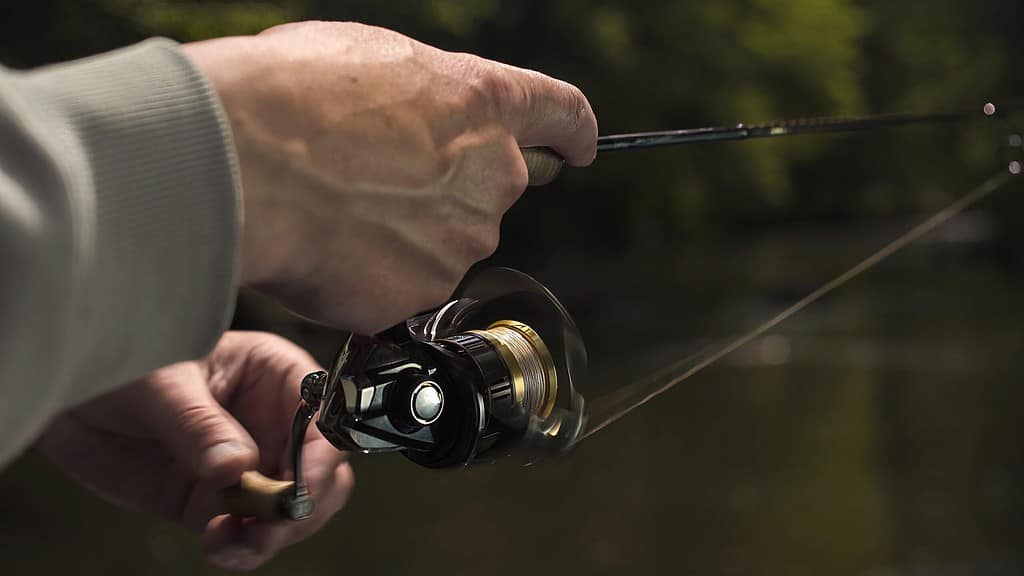
The toolkit for spin fishing is as straightforward as a melody.
To be a spin fisherman, you’ll need spin fishing rods, fishing line, hooks, and bait. The rod, typically sturdier than a fly fishing rod, is the backbone of your performance. The line, delicate and thin, follows the lead of the bait or a sinker, guiding your hook into the water’s depths. And the bait? It’s a versatile performer, playing roles from live worms to artificial fishing lures.
Fishes Commonly Caught With Spin Fishing
With spin fishing, you can serenade a broad array of fish.
This versatile method helps you catch fish and charm many species into biting. Bass, catfish, pike, and walleye often fall for the allure of spin fishing. With the right bait and stage, you can even entice saltwater stars like cod, flounder, and redfish to join the show.
Pros and Cons of Spin Fishing
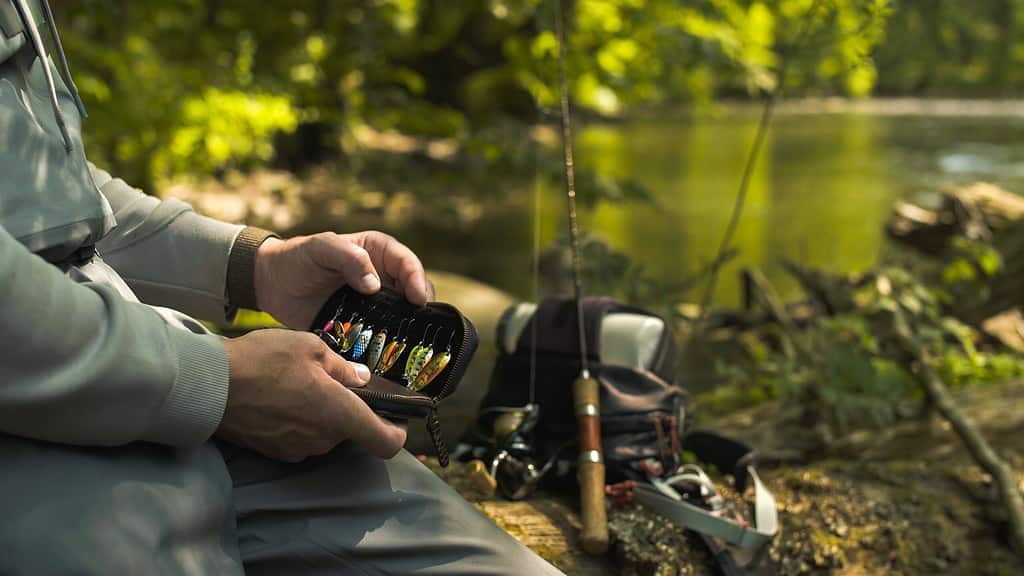
Spin fishing, like any good performance, presents its own challenges.
While it may be simpler to pick up than the complex dance of fly fishing, it demands its own set of skills. You need to understand where to find the fish, what tantalizing bait they prefer, and how to reel them in without snapping your line.
But the rewards are sweet: the thrill of feeling a fish tug on your line, the excitement of reeling it in, and the satisfaction of a successful catch.
Spin fishing has pros and cons, too.
One of the high notes of spin fishing is its simplicity. It’s like learning the first notes of a song; easy for beginners, and you can perform from a variety of stages – the shore, a dock, or a boat. Typically, it’s also lighter on the wallet compared to the ballet of fly fishing. However, it’s less energetic than fly fishing and can ask for a symphony of patience. Depending on the fishing locale, you may find yourself in a chorus of anglers vying for prime fishing spots.
Yet, in spite of these challenges, spin fishing retains its title as a favorite sport.
It’s a tranquil way to commune with nature, bask in the outdoors, and reel in some aquatic stars. Whether you’re a rookie learning the scales or a seasoned pro composing symphonies, there’s always a fresh note to discover in the melody of regular fishing.
Key Differences Between Fly Fishing vs Spin Fishing
Fly fishing and spin fishing are two sides of the same coin.
They’re both about catching fish, but the techniques, environments, gear, and skills required are quite different. Let’s dive into these differences.
Techniques: Fly fishing vs. Regular fishing
Fly fishing is like an elegant dance. You cast a lightweight fly back and forth in the air, then let it land gently on the water’s surface. It’s about precision and timing.
Spin fishing, on the other hand, is more like a waiting game. You cast your baited hook into the water and wait for a fish to bite. It’s a more passive approach.
Environments and Conditions: Fly fishing vs. Regular fishing
Fly fishing typically happens in moving waters like rivers and streams. It’s best when the weather is warm, and insects are active, attracting fish to the surface.
Regular fishing is more versatile. You can do it in lakes, ponds, rivers, or the sea, in almost any weather. You can fish from the shore, a dock, or a boat.
Gear and Cost: Fly fishing vs. Regular fishing
Fly fishing requires specialized gear: a fly rod, fly line, and flies. This gear can be more expensive than spin fishing equipment.
Regular fishing gear – a rod, line, hooks, and bait – is simpler and typically less costly.
Learning Curve and Skills Required: Fly fishing vs. Regular fishing
Fly fishing has a steep learning curve. It requires physical skill for casting and a good understanding of insect behaviors and river currents.
Regular fishing is easier for beginners. Regular fishing is composed of simpler techniques, like casting and reeling in. But to hit the right notes, you still need to learn about different fish species, their habits, and the best bait to use.
Ultimately, choosing between fly fishing and regular fishing depends on the melody you want to create. Are you craving an active, challenging escapade amidst nature’s orchestra? Try fly fishing. Regular fishing will conduct your perfect symphony if you’re more inclined towards a tranquil, patient rhythm.
Both offer the joy of fishing, just in different ways.
Choosing the Right Fishing Method for You
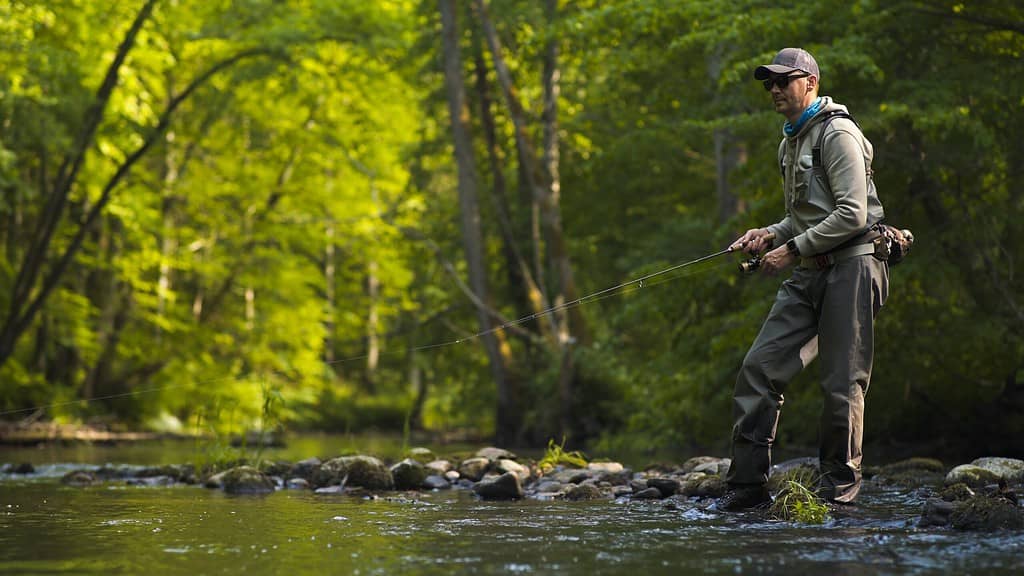
Choosing between fly fishing and regular fishing is like swimming and surfing.
Both are fun, but your choice will depend on several factors: your physical ability, patience level, budget, and what you want from your fishing experience.
Physical Ability and Patience Level
Fly fishing involves more movement and requires good timing and coordination.
On the other hand, if you prefer a more relaxed approach, regular fishing is a better choice. It involves patience and the ability to stay calm and wait for the fish to bite.
Budget
Consider your budget. Fly fishing gear can be expensive, while regular fishing gear is typically more affordable.
Fishing Experience
Think about what you want from your fishing experience. If you enjoy learning about insect behaviors and river currents, fly fishing can be rewarding. You might enjoy regular fishing more if you prefer a simple, relaxing day by the water.
Expert Tips for Beginners
For beginners in fly fishing, practice your casting technique. Start with short, simple casts and gradually work up to longer ones. Also, learn about the insects in your fishing area and what stages of life the fish prefer to eat.
For beginners in regular fishing, learn about the fish in your area. What do they eat? Where do they like to hang out? Also, practice casting and reeling in, so you’re ready when a fish bites.
Remember, whether you choose to fly fishing or regular fishing, the goal is to enjoy yourself. Happy fishing!
Final Thoughts
Choosing between fly fishing and regular fishing is a personal journey.
You’ve learned that fly fishing is an active, challenging sport. It’s a dance between you, the fly, and the fish. It requires special gear, knowledge about insects, and skill in casting.
In contrast, regular fishing is akin to a peaceful serenade. It’s an opportunity to unwind, gaze upon the water’s surface, and experience the rush when a fish nibbles at your bait. The gear is more straightforward, and the technique is more in tune with beginners.
But remember, this isn’t a binary choice. You can test the waters with both methods and see which resonates with you. You might find that you enjoy both, choosing one or the other based on your mood, the changing seasons, or the symphony of fishing conditions.
So, why not cast a line in both worlds?
Pull on your fishing hat, grab a rod, and head to the water. Whether fly fishing in a bubbling stream or casting a line from a tranquil lakeshore, the joy of fishing awaits. The fish are waiting – it’s time to cast your line and see what you can reel in. Happy fishing!





 Facebook
Facebook YouTube
YouTube
